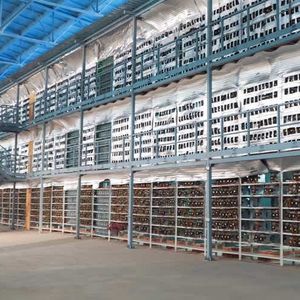Bitfarms: Q1 Was A Strategic Reset Toward HPC And AI (Rating Downgrade)
5 min read
Summary Bitfarms’ Q1 results show strong revenue growth but significant margin compression and deepening losses, highlighting cost pressures post-Bitcoin halving. The $300M Macquarie loan supports a strategic pivot into HPC, reducing dilution risk but introducing execution and speculative revenue risks. Bitfarms’ U.S. expansion, now 80% of its energy pipeline, positions it to capitalize on AI and HPC infrastructure growth where capital is concentrated. While Bitfarms is operationally and strategically upgraded, investors should watch for HPC monetization over the next 2–3 quarters before re-rating. It’s been a gut-check season for Bitcoin ( BTC-USD ) miners that have reported earnings this month, and we’ve seen mostly mixed bag financial results, which most management attributed to the April 2024 Bitcoin halving event. With all the equity funding and loans undertaken in 2024 by miners, I think by now miners should have scaled mining operationally and strategically and be better positioned for the next leg of the cycle and the next halving. Or is mining becoming the second fiddle and all focus now on HPC? It seems. Results are in for Bitfarms (NASDAQ: BITF ), and I must say Bitfarms results aren’t exactly impressive despite the YoY top line growth. My very first and most recent coverage of Bitfarms (in June last year) was around the time of Riot Platform’s ( RIOT ) proposed takeover of Bitfarms at $2.30 per share (about 25–30% premium at the time) and at a total equity value of $950 million. Riot remains one of the best-capitalized miners in the space, and a takeover interest signaled market confidence in Bitfarms’ undervaluation. I thought BITF had found a floor at that price point at that time, and whether the takeover went through or fell through, there would be limited downside and potential strategic upside for investors. The Buy rating I issued at the time was based on that premise, and the stock has since fallen by over 50% to today’s price of $1.10. Bitfarms Q1 2025 financial snapshot (Bitfarms) Bitfarms reported Q1 total revenue of $67 million, up 33% Y/Y and beating estimates by $ 1.89 million. Gross margin decreased by 20 percentage points YoY from 63% to 43%. SG&A expenses increased to $20 million, a ~53% jump from last year’s, including a non-recurring $2 million cost related to the closing of the Stronghold acquisition. This puts adjusted EBITDA margin at 23%, a 26 percentage point drop from 46% a year ago. Net loss deepened to $36 million and basic EPS was -$0.07, missing consensus estimates by $0.04. Operating loss deepened to $32 million compared to $24 million in Q1 2024. Overall, the results reflect cost pressures and margin compression despite stronger revenue. Operationally, Bitfarms increased its hashrate under management by 200% from a year ago. Exahashes under management now stands at 19.5 EH. Mining efficiency as if Q1 end was 19 watts per terahash, a 44% improvement compared to a year ago. More Debt, Less Dilution We are excited to have joined forces with Macquarie to finance our HPC business cost-effectively and with much less dilution than equity funding, creating long-term value for shareholders. – CFO Jeff Lucas Those were the words of the CFO of Bitfarms in the commentary of the Q1 earnings. There will be less dilution moving forward. But Bitfarms just secured a $300 million loan facility from Macquarie. The funds are earmarked for developing the Panther Creek HPC data center. This is strategic and doesn’t pose any near-term threat to the balance sheet since net asset remain positive, though total liabilities have increased from $59.6 million to $112.2 million due to the $50 million first tranche out of the $300 million debt facility drawn in Q1. Equity position is also strong at $664.7 million (lots of dilution happened last year), and BTC holdings are currently 1166 BTC amounting to ~$121 million as of today’s ~$104,000 BTC price. I believe the $300 million debt can be well absorbed within the capital structure without any near-term financial strain. The only concern I’d have as an investor is the fact that Bitfarms’ HPC business and its success remain entirely speculative at this point. No sales have been recorded yet from HPC. While Panther Creek has strategic advantages like scale, power access, and fiber connectivity, execution risk remains high, and any execution missteps could burden Bitfarms with fixed obligations from this loan, and in turn strain liquidity and likely delay ROI. Other Operational Highlights from Bitfarms’ Q1 First, we completely transformed our energy portfolio with the strategic and profitable disposition of one of our Paraguayan Bitcoin mining campus, Yguazu, and the strategic acquisition of two large power campuses in Pennsylvania with the Stronghold acquisition. – CEO Ben Gagnon Bitfarms is executing a clear exit from regions where the economics don’t offer long-term upside. The bigger picture is now the strategic pivot to the U.S., where ~80% of Bitfarms’ 1.4 GW energy pipeline is now concentrated. This matters. U.S.-based miners have been capitalizing on structural advantages in energy arbitrage and regulatory incentives, take RIOT and the ERCOT demand response program for example, an income stream the miner taps into to improve cash flow during periods of high energy prices or market volatility. Experimentation with international expansion has largely underperformed and introduced more risk than upside for most miners pivoting to HPC. A new strategic play I think investors should watch for, especially for miners pivoting into HPC, is the localization of infrastructure near major U.S. power grids, which brings them closer to potential enterprise HPC clients. The sheer size of private AI investment in the U.S. offers better economics and stronger return potential. Private AI investment in the U.S ($109.1 billion in 2024) is way bigger compared to the rest of the world, and is even 12 times higher than that of China (at $9.3 billion in 2024), the next closest rival. The preceding figures can be found in Stanford University’s 2025 AI Index report . Takeaway As the strategies in Q1 shows, Bitfarms is clearly evolving from a traditional Bitcoin miner into a diversified infrastructure player with long-term ambitions in HPC and AI hyperscaling (much like the strategic trend among miners currently). The Q1 results, while reflecting YoY top-line growth (BTC price is much higher compared to a year ago so top line growth is unsurprising) and operational scale, a closer look at the expansion strategy also highlights the cost pressures and potential execution risk that come with aggressive expansion into HPC. The $300 million debt facility secured with Macquarie is great as it is targeted for a high-potential vertical. But until revenue materializes from HPC, it remains a speculative bet. That said, Bitfarms’ strong equity base of $664.7 million and $186 million in combined cash and BTC holdings provides ample cushion in the near term. The U.S. pivot is the bigger structural story here. Bitfarms is aligning itself with where the capital is flowing not just in energy arbitrage, but in future-proof computing demand. With 80% of its 1.4 GW pipeline now in the U.S., Bitfarms is better positioned to tap into HPC and AI infrastructure growth, especially as enterprise AI spending in the U.S. vastly outpaces other markets. Execution remains key. Investors should watch for initial HPC contracts, utilization metrics, and cash flow trends over the next 2–3 quarters. Until then, Bitfarms sits in a liminal space – operationally upgraded, strategically well-positioned, but still awaiting proof of monetization beyond Bitcoin.

Source: Seeking Alpha



